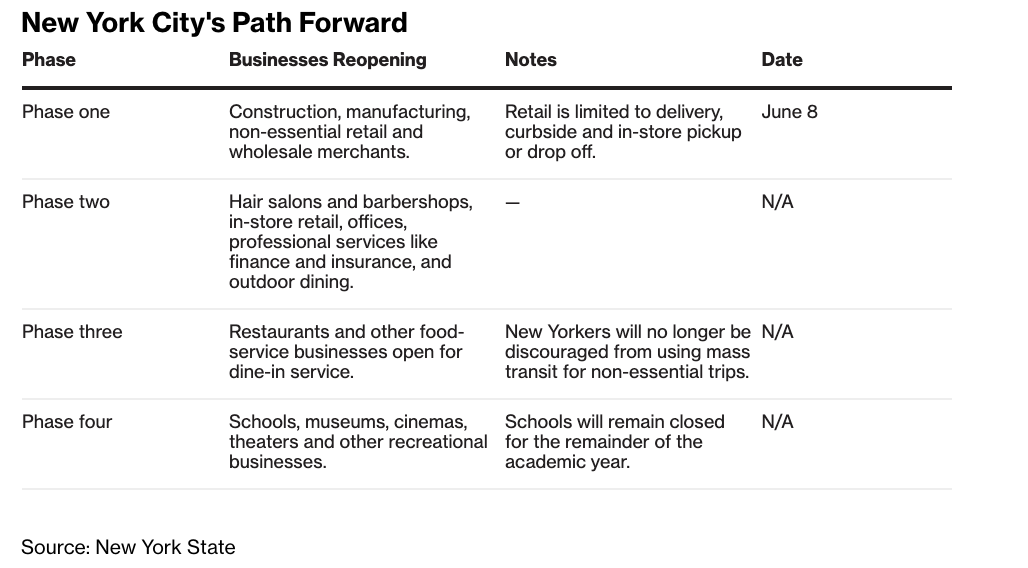Here Is Everything New Yorkers Need To Know About ‘Phase 1’ Reopening
Tyler Durden
Mon, 06/08/2020 – 10:25
NYC is taking its first tenuous step toward normalcy 100 days after reporting its first confirmed case of COVID-19.
Given all the changes, mixed messages between state, local and federal officials, and general confusion and chaos during what has been a trying time for America, it’s understandable that some NYers understanding of the ‘Phase 1’ guidelines might be less-than-clear.
To try and remedy that, BBG has published a summary of what changes during Phase 1, and what remains the same:
What does ‘Phase One’ reopening mean?
This is the first of a four-step process that will gradually ease restrictions on business activity and people’s ability to move around and socialize in the state of New York. The progress is contingent on infection rates, hospital capacity and the state’s ability to test and trace those who may have contracted the virus. Regardless, each phase will last at least two weeks.
Some parts of the state that opened up in mid-May have already entered the second stage, as shown on this monitoring dashboard. New York City, the epicenter of the outbreak in the U.S., is the last region to meet the requirements to start reopening.
Must I still keep social distancing and avoid seeing friends?
You can see friends and others — but remain careful. A May 22 executive order from New York Governor Andrew Cuomo said groups of up to 10 people can gather for any lawful reason. (It was introduced after a lawsuit challenged a prior order, which eased distancing rules for Memorial Day activities and religious services only.) But health experts still advise New Yorkers to practice social distancing and wear face protections in public.
Are trains, buses and ferries still running, and are they safe?
Unless you’re an essential worker or on an essential trip, you should refrain from riding at all. But if you must, a few ground rules apply: If possible, avoid rush hours and keep your distance. Always wear a face mask. Don’t skimp on the hand sanitizer. And once you reach your destination, wash your hands. If you’re still worried, you can always remind yourself that both vehicles and stations are now being cleaned more frequently than before the virus outbreak.
MTA SUBWAY AND BUSES: Both will be back on their normal day schedules starting Monday, but trains still won’t run between 1 a.m. and 5 a.m. Tickets can only be bought from kiosks, not from station agents. The agency plans to post staff and volunteers in some stations to give hand sanitizer and face masks to customers who need them.
FERRIES: The Staten Island Ferry will run on a modified schedule — departures in both directions every half hour — during weekday mornings and evenings. At all other times, departures will be hourly. The East River Ferry will continue running at about half capacity, and daily service ends at about 9 p.m.
METRO-NORTH & LONG ISLAND RAILROAD: Both expanded their limited-service schedules last month as areas outside the city began reopening. Metro-North now runs additional city-bound trains in the morning and in the opposite direction in the evening, and LIRR has increased capacity by 15%. Ticket counters remain closed, so passengers must use kiosks or the MTA app. But on the upside, off-peak fares will apply to all rides.
NEW JERSEY TRANSIT: Trains and buses are still operating. The concourse in New York’s Penn Station will be closed for cleaning every night between 1 a.m. and 5 a.m., but customers can still enter via the main entrance on 7th Avenue and 32nd Street. Those with paper tickets will be asked to tear those themselves to minimize hand-to-hand contact with staff.
AMTRAK: The train operator has pared back its trips nationwide, but still runs regional trains in the Northeast. It also resumed its popular Acela route between Boston and Washington earlier this month — though on a reduced schedule. Customers can still buy food and drinks onboard, but there’s no seating in the dining cars.
Are stores open again?
A variety of nonessential businesses can now open up again, including retailers that sell clothes, jewelry, sporting goods, books and furniture – but customers still can’t enter. For now, retailers must stick with curbside pickup and delivery. That, combined with damage incurred during the recent protests and worries about profitability, has led some stores to keep their doors closed a bit longer.
Those that do reopen must follow a strict protocol for cleaning and sanitation, ensure proper social distancing and provide employees with face masks. The state also recommends businesses stagger workers’ schedules.
What about parks?
Many parks with green spaces have remained open while playgrounds and basketball courts have been closed. The city hasn’t yet set a date for when the shuttered areas will reopen.
When will I be able to go back to my office?
The short answer: It depends. Most companies are taking a cautious approach and they’ll likely send employees back to offices in waves rather than all at once. Even so, the governor’s plan doesn’t permit offices to reopen until Phase Two, which at the very earliest will be two weeks from now.
What happens if New York sees a surge in cases and no longer meets the state’s reopening requirements?
For now, it’s unclear how that will be handled.
* * *
Source: Bloomberg
